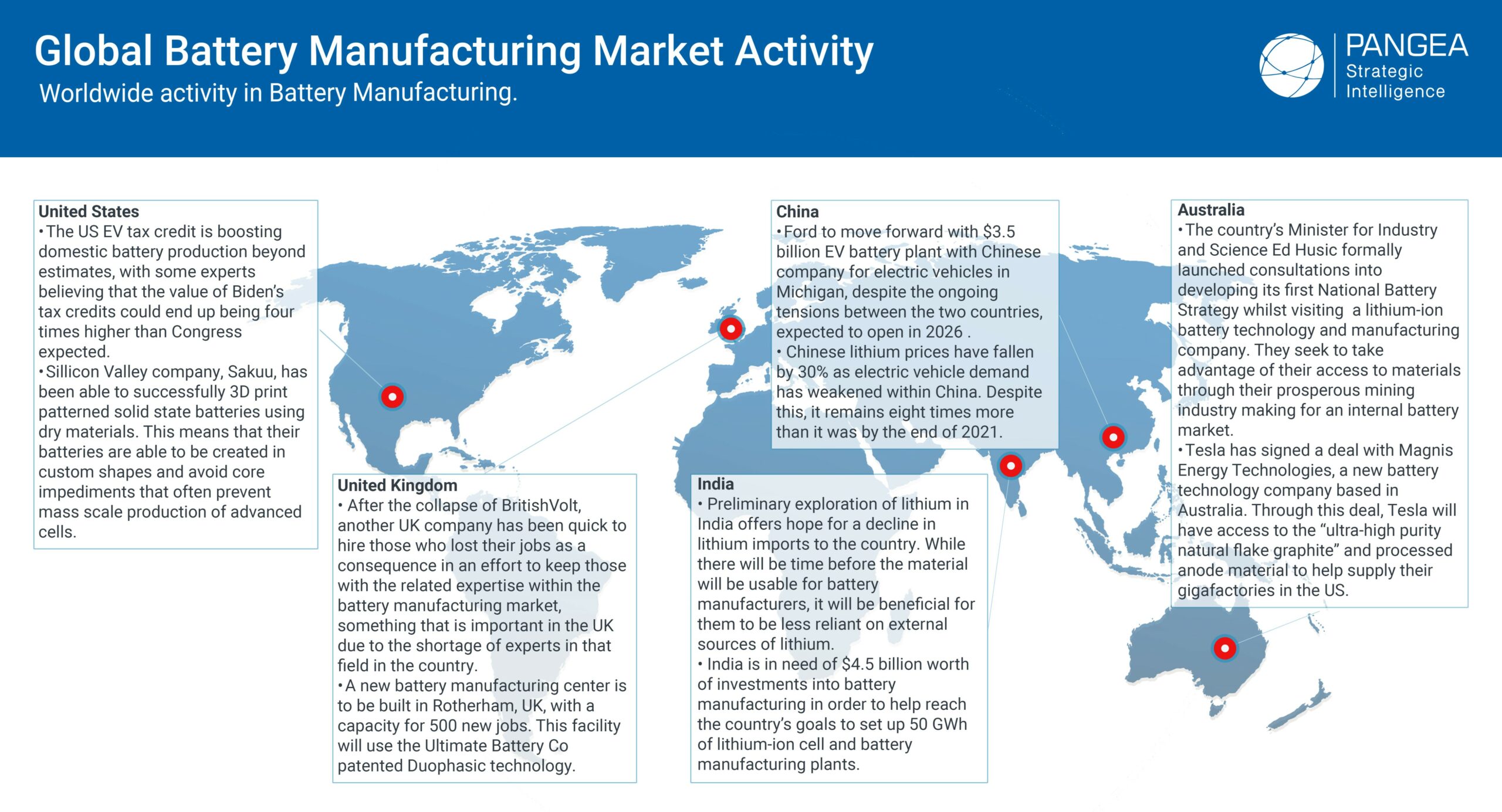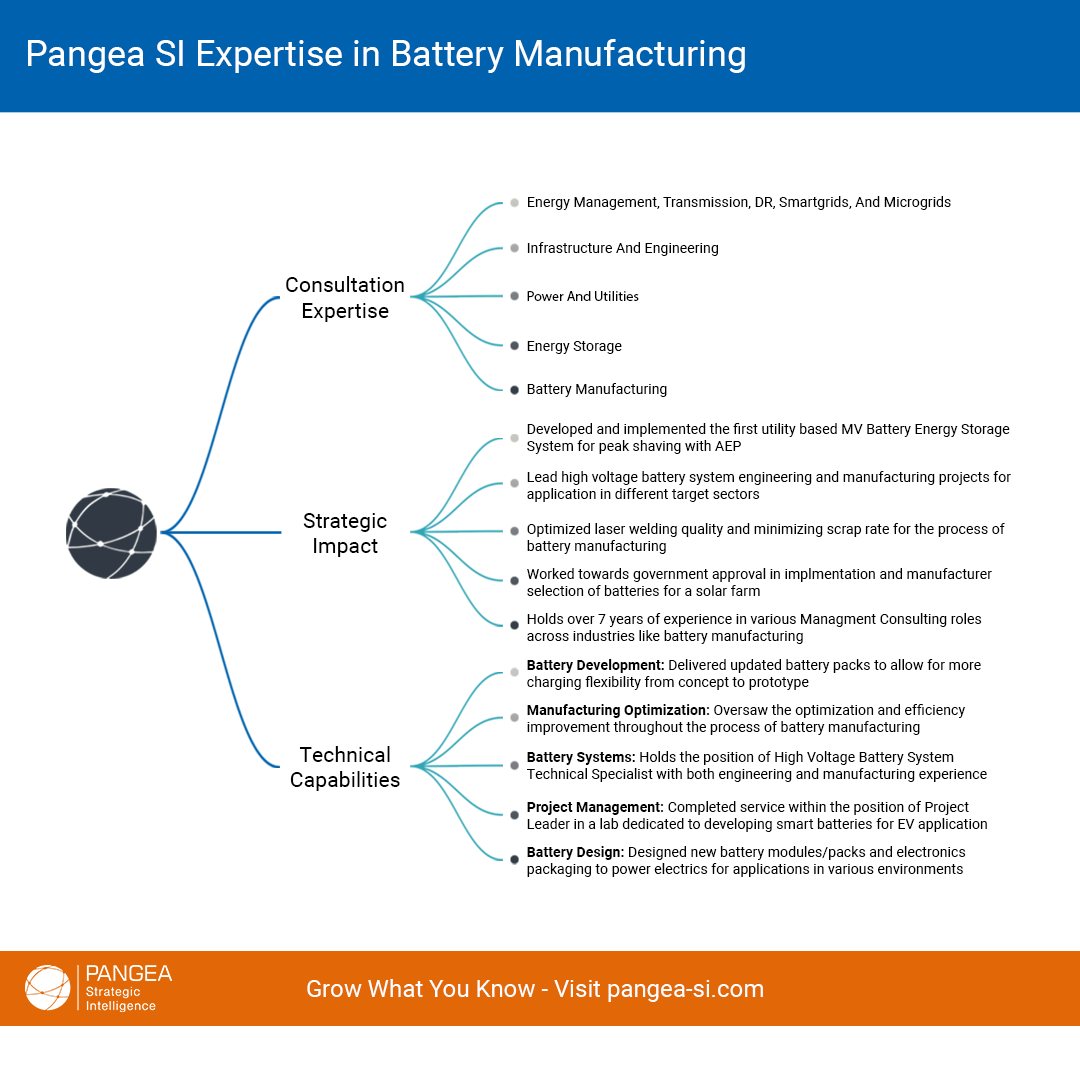The cost of producing batteries is being driven down by reduced pricing for raw materials (such as lithium and cobalt) and economies of scale; over the past ten years, the cost of lithium-ion battery packs has decreased by 90%. When more and more uses become commercially viable, this fuels additional expansion.
Battery manufacturing typically involves four main stages:
The first stage of battery manufacturing involves the production of battery materials such as electrodes, electrolytes, and separators. These materials are typically made using chemical reactions that require specialized equipment and expertise. Electrodes are made by coating a metal foil with active material and then adding a binder and conductive additives. Electrolytes are made by mixing salts and solvents to create a conductive solution, and separators are made from porous materials that allow ions to pass through but prevent the electrodes from touching.
The second stage of battery manufacturing involves the assembly of individual cells. This process involves stacking the electrodes and separators together and then adding the electrolyte. The cells are then sealed to prevent leakage and contamination.
The third stage of battery manufacturing involves the assembly of battery modules. A module is a group of cells that are connected in a specific configuration to achieve a desired voltage and capacity. The modules are typically housed in a metal or plastic case that provides protection and structural support.
The final stage of battery manufacturing involves the assembly of battery packs. A pack is a group of modules that are connected in a specific configuration to achieve a desired voltage and capacity. The packs are typically housed in a metal or plastic case that provides protection and structural support. The packs are then tested to ensure they meet performance and safety standards.
High-capacity long-life battery development is particularly important for the utility and transport sectors. A key enabler of their success is likely to be the lithium-ion battery — most commonly used for small-scale applications like phone chargers but increasingly being developed for larger-scale applications. Seven European countries have already committed EUR 3.2 billion to support research into lithium-ion batteries, and both Tesla and General Motors are investing billions of dollars in manufacturing facilities for the technology.
Battery waste is an avoided topic when it comes to the renewable energy transition. By 2030, there could be 11 million tonnes of lithium-ion battery waste from electric vehicles alone, enough to fill London’s Wembley Stadium almost 20 times over. Combined with the growth of renewable energy for utilities, as well as other battery-driven devices, this adds up to a large and growing problem that needs to be managed.
Battery manufacturing is a complex process that involves several challenges. Some of the main challenges include:
Cost: Battery manufacturing can be expensive due to the high cost of materials and the need for specialized equipment and expertise.
Safety: Battery manufacturing can be dangerous due to the potential for fires and explosions if the batteries are not manufactured or handled properly.
Environmental Impact: Battery manufacturing can have a significant environmental impact due to the chemicals and materials used in production. It is important to manage these impacts through proper waste disposal and recycling programs.
Scalability: Battery manufacturing can be challenging to scale up to meet growing demand. This is because it can take time to build new manufacturing facilities and train new staff.
Reducing transportation emissions, which currently account for 30% of world emissions, is crucial. Although initial expenses are greater, running an electric vehicle is typically less expensive than one powered by fossil fuels. This motivates consumers to make the switch and aids in the decarbonization of road transportation.
Batteries are becoming a crucial component of the sustainable transportation of the future because of advancements in battery technology. The power stored in these mobile batteries can be utilised to both powers your home and provide grid stabilisation. One of these platform technologies that can be used to better the planet and stop climate change is the utilisation of batteries.
Despite the challenges, the battery manufacturing industry is growing rapidly, driven by the demand for electric vehicles and renewable energy storage. Some of the key trends in battery manufacturing include:
Many battery manufacturing companies are investing in automation to increase efficiency and reduce costs. This includes the use of robots to assemble cells and modules, as well as the use of software to monitor and optimize the production process.
Battery recycling is becoming increasingly important as the demand for batteries grows. Many battery manufacturers are investing in recycling programs to recover valuable materials from used batteries and reduce waste.
Solid-state batteries are a promising new technology that could provide higher energy densities and improved safety compared to traditional lithium-ion batteries. Many battery manufacturers are investing in the development of solid-state batteries.
Battery manufacturers are increasingly integrating renewable energy sources such as solar and wind into their production processes to reduce their environmental impact and improve their sustainability.
| CATL 34% China CATL, or Contemporary Amperex Technology Co. Limited, is a Chinese battery manufacturer that specialises in lithium-ion EV batteries. CATL, the world’s largest lithium-ion battery manufacturer, is responsible for 96.7 gigawatt hours (GWh) of the planet’s total of 296.8 GWh. CATL, as one of the world’s largest and most popular car battery companies, will undoubtedly prioritise excellence and innovation in the years ahead. |
LG Energy Solution 14% Korea Interestingly, LG has been producing far more than just EV batteries for many years. LG batteries are responsible for everything from phone batteries to car batteries and can be built in a variety of shapes and sizes for maximum capacity and efficiency. LG’s electric car batteries can travel over 500 kilometres on a single charge and can be charged to 80% in as little as 30 minutes. |
| BYD 12% China BYD, Ltd. — an abbreviation for Build Your Dreams — is a Chinese manufacturing conglomerate that is currently hard at work developing an EV battery that will redefine the industry’s pre-existing safety standards. BYD was founded with the goal of eradicating safety concerns once and for all, and it now ranks among the largest and most important battery companies as a result of this determination and drive to do something new and better. |
Panasonic 10% Japan Panasonic lithium-ion batteries are used in hybrid and electric vehicles (including Tesla, which relies on Panasonic and Panasonic alone for its advanced battery). Panasonic’s lithium batteries, developed in close collaboration with car manufacturers, are both efficient and environmentally friendly. Being mindful of one’s environmental impact is as important to Panasonic as developing an efficient and effective car battery. This is what makes them one of the world’s best and most important battery companies. |
| SKI 7% Korea SK Innovation, also known as SKI, has been a pioneer in the Korean energy industry for over a half-century. SKI’s lithium-ion batteries were the first to successfully introduce high-energy ternary materials to the electric vehicle industry, making them an essential part of this list of the world’s largest and most important battery companies. SKI may be limited to South Korea for the time being, but there is no doubt that their remarkable technology will spread throughout the world in the coming years. |
Battery manufacturing is a complex process that involves several stages and challenges. However, the growth of the electric vehicle and renewable energy industries is driving demand for batteries, and the industry is evolving to meet these demands.
Many people believe that the future will be electric. Without a doubt, the world will soon be mostly or completely charged electrically. As a result of the increasing demand for batteries, there should be some cost-cutting plans in place to ensure that the world produces enough batteries and electric technologies. Finding a way to reduce the number of metals in batteries that are expensive, difficult to obtain, or problematic because their mining has a negative impact on the environment is one way to accomplish this. In order to make the transition to a greener society, society should prioritise recycling, which includes improved battery recycling.


Clients notify us that they need leading insight for their project.
We engage and vet subject matter Experts matched to the request at speed.
Clients consult with their shortlisted Expert(s) and obtain forward knowledge to incorporate into their strategic plans.
Clients benefit from more refined analysis and practical guidance to achieve a quantifiable business impact.